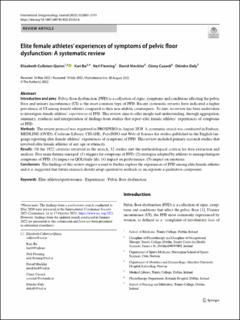| dc.contributor.author | Culleton-Quinn, Elizabeth | |
| dc.contributor.author | Bø, Kari | |
| dc.contributor.author | Fleming, Neil | |
| dc.contributor.author | Mockler, David | |
| dc.contributor.author | Cusack, Cinny | |
| dc.contributor.author | Daly, Déirdre | |
| dc.date.accessioned | 2022-11-29T16:58:47Z | |
| dc.date.available | 2022-11-29T16:58:47Z | |
| dc.date.created | 2022-09-02T09:04:04Z | |
| dc.date.issued | 2022 | |
| dc.identifier.citation | International Urogynecology Journal. 2022, 33(10), Side 2681-2711. | en_US |
| dc.identifier.issn | 0937-3462 | |
| dc.identifier.uri | https://hdl.handle.net/11250/3034840 | |
| dc.description | This article is licensed under a Creative Commons Attribution 4.0 International License, which permits use, sharing, adaptation, distribution and reproduction in any medium or format, as long as you give appropriate credit to the original author(s) and the source, provide a link to the Creative Commons licence, and indicate if changes were made. The images or other third party material in this article are included in the article's Creative Commons licence, unless indicated otherwise in a credit line to the material. If material is not included in the article's Creative Commons licence and your intended use is not permitted by statutory regulation or exceeds the permitted use, you will need to obtain permission directly from the copyright holder. | en_US |
| dc.description.abstract | Introduction and aims: Pelvic floor dysfunction (PFD) is a collection of signs, symptoms and conditions affecting the pelvic floor and urinary incontinence (UI) is the most common type of PFD. Recent systematic reviews have indicated a higher prevalence of UI among female athletes compared to their non-athletic counterparts. To date, no review has been undertaken to investigate female athletes’ experiences of PFD. This review aims to offer insight and understanding, through aggregation, summary, synthesis and interpretation of findings from studies that report elite female athletes’ experiences of symptoms of PFD.
Methods: The review protocol was registered in PROSPERO in August 2020. A systematic search was conducted in Embase, MEDLINE (OVID), Cochrane Library, CINAHL, PsycINFO and Web of Science for studies published in the English language reporting elite female athletes’ experiences of symptoms of PFD. This review included primary research studies that involved elite female athletes of any age or ethnicity.
Results: Of the 1922 citations retrieved in the search, 32 studies met the methodological criteria for data extraction and analysis. Five main themes emerged: (1) triggers for symptoms of PFD; (2) strategies adopted by athletes to manage/mitigate symptoms of PFD; (3) impact on QOL/daily life; (4) impact on performance; (5) impact on emotions.
Conclusions: The findings of this review suggest a need to further explore the experiences of PFD among elite female athletes and it is suggested that future research should adopt qualitative methods or incorporate a qualitative component. | en_US |
| dc.language.iso | eng | en_US |
| dc.subject | athletes | en_US |
| dc.subject | elite athletes | en_US |
| dc.subject | elite sportswomen | en_US |
| dc.subject | experiences | en_US |
| dc.subject | pelvic floor dysfunction | en_US |
| dc.subject | sportswomen | en_US |
| dc.title | Elite female athletes’ experiences of symptoms of pelvic floor dysfunction: A systematic review | en_US |
| dc.type | Peer reviewed | en_US |
| dc.type | Journal article | en_US |
| dc.description.version | publishedVersion | en_US |
| dc.rights.holder | © The Author(s) 2022 | en_US |
| dc.source.pagenumber | 2681-2711 | en_US |
| dc.source.volume | 33 | en_US |
| dc.source.journal | International Urogynecology Journal | en_US |
| dc.source.issue | 10 | en_US |
| dc.identifier.doi | 10.1007/s00192-022-05302-6 | |
| dc.identifier.cristin | 2048144 | |
| dc.description.localcode | Institutt for idrettsmedisinske fag / Department of Sports Medicine | en_US |
| cristin.ispublished | true | |
| cristin.fulltext | original | |
| cristin.qualitycode | 1 | |
